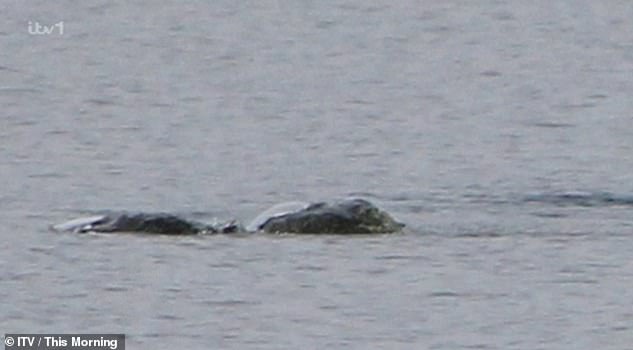I’m a Nessie Hunter and felt it was my duty to share ‘exciting’ photos of the monster with the public
A Nessie hunter felt it was “his duty” to post recent viral photos of the legendary monster in the public domain, as he “realized it’s not just something he can keep to himself and not share with the outside world.”
The snaps of Loch Ness in Scotland were originally taken by Chie Kelly in 2018, who initially refused to show them for fear of public ridicule.
Speaking to This Morning, fellow Nessie aficionado Steve Feltham revealed that he first saw the photos last weekend – and was “totally surprised.”
She said, “I’m just showing you these for your own personal interest,” he explained.
But the eerie image, with two bumps in the water, was too convincing for Steve not to share with fellow enthusiasts.
Speaking to This Morning, fellow Nessie aficionado Steve Feltham revealed he first saw the photos last weekend – and was “totally surprised”
“I’m used to people bringing me pictures and saying, ‘Oh, I think I caught Nessie,'” he explained.
“In general I can look at it and 90 percent of the time I say, that’s a boat, or that’s wind, or that’s waves on the water.”
But he had “no idea” what the two bumps in the photo could be.
“This is definitely as good as it gets, as exciting as it gets for Nessie hunters around the world,” he added.
Steve explained that he doesn’t think the two small hilly structures are rocks, as he would have noticed them after living by the lake for more than thirty years.
“It’s in about 80 feet of water, so if there was a little atoll sticking out of the water in 32 years, I probably would have known about it because now water skiers and swimmers would have been on it,” he said.
“There are absolutely no stones.”
The Nessie fighter also expressed shock at not noticing the bumps in 2018, joking that he “must have been at the supermarket the day she came out and took those pictures.”

The eerie image, with two bumps in the water, was too convincing for Steve not to share with fellow enthusiasts
However, biologist Professor Ben Garrod told the program that they think the bumps are something much less exciting, like debris from a boat or a piece of wood.
He added that he does not believe Nessie to be a prehistoric monster, as these were huge and sometimes violent, fast creatures, who would have made their presence known by now.
“As a biologist, I would say, if we’re looking for an animal and haven’t seen it for fifty years or so, or we don’t have conclusive evidence that it’s there, then it’s extinct.”
However, he thought it might be “a huge fish.”
He also praised the work of Steve and other Nessie Hunters as important “citizen science.”
“It’s very important that people like Steve dedicate their lives to further understanding the things that could be out there,” he said.
It comes as Nessie hunters claim to have made three separate sightings of the elusive creature, including the “most thrilling” glimpse of the legendary beast yet.
Volunteers flocked to the Scottish Highlands this weekend to take part in the biggest hunt for the Loch Ness Monster in over 50 years.
The search expedition led to three reported sightings, including the “first-ever video” of Nessie, captured by a film crew using a thermal imaging drone.
Meanwhile, another viewfinder claimed she captured the “most exciting” photos of Nessie ever.
The footage, created by translator Chie, shows an eel-like creature slowly spinning on the surface of Loch Ness shortly before it submerged.
An official, 58, also reported seeing Nessie swimming in Loch Ness before sketching a picture of the world-famous monster.
The search for the Loch Ness Monster began on August 26, when hundreds of intrepid Nessie hunters took to the loch for the largest search of its kind in decades.
The volunteers included a film crew from British production company Dragonfly Films, who used a thermal imaging drone to search for the creature.
Their search, in turn, led them to create images they believe may show the elusive Loch Ness Monster near the shore of the Scottish loch.
Chie, 51, later captured what she believes are photos of the Loch Ness Monster while snapping photos of her husband Scott, 68.
She soon began taking pictures after seeing a strange animal moving from right to left for about 100 meters at a ‘constant speed’, about 200 meters from shore.
‘We had lunch at the Dores Inn and then went for a walk around. I was just taking pictures with my Cannon camera of Scott and our daughter Alisa, who was five at the time, when about 200 yards from shore this creature was moving from right to left at a constant speed,” she said.
“It was twisting and rolling at times. We never saw a head or neck. After a few minutes it just disappeared and we never saw it again,” the Japanese-born translator added.
‘At first I wondered if it was an otter or a pair of otters or a seal, but we never saw a head and it never came up for air.
“It made a strange movement on the surface. We didn’t hear any sound. There were strange shapes beneath the surface. I couldn’t distinguish colors, the water was dark.’
‘I couldn’t estimate the length exactly, but the two visible parts together were less than two meters long.
‘I don’t know what it was, but it was definitely a creature, an animal. At the time I didn’t want to be publicly ridiculed by publishing the photos.’

